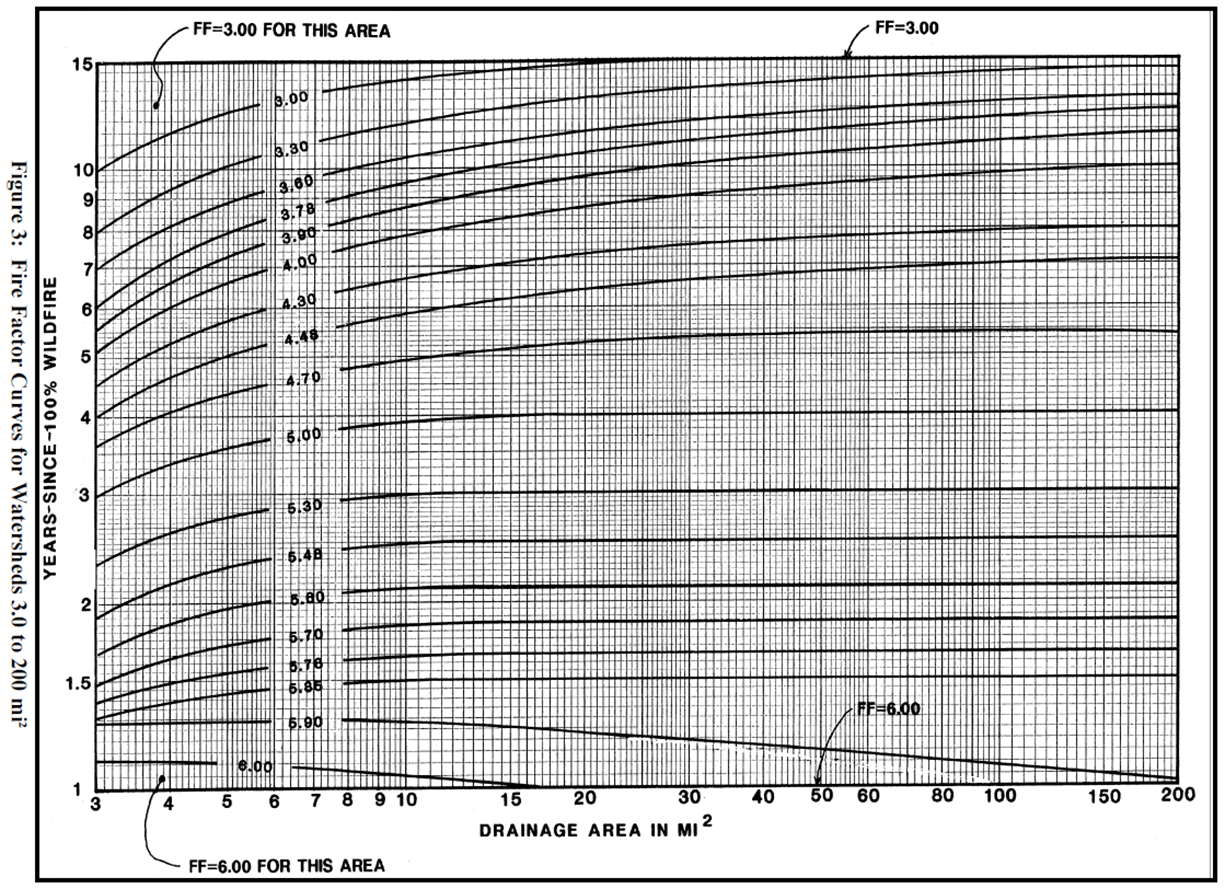Download PDF
Download page LA Debris Equations 2-5.
LA Debris Equations 2-5
The Los Angeles District Debris Method - Equation 2 Through 5 (Gatwood, Pedersen, and Casey, 2000) was developed from statistical analysis of data from watersheds with an area from 3.0 mi² to 200.0 mi². This method may also be used for drainage areas less than 3 mi2. The Los Angeles District Debris Method EQ 2-5 works best in arid or semi arid regions of Southern California where it was developed. The Component Editor is shown in the next two figures.
Los Angeles District Debris Method - Equation 2
The Los Angeles District Debris Method - Equation 2 (Gatwood, Pedersen, and Casey, 2000) is employed to simulate events in watersheds ranging from 3 mi² to 10 mi² in size.
| \begin{aligned} & \log D_y=0.85(\log Q)+0.53(\log R R)+0.04(\log A)+0.22(F F) \\\\ & D_y=\text { Unit Debris Yield }\left(y d^3 / \mathrm{mi}^2\right) \\ & Q=\text { Unit Peak Runoff }\left(ft^3/s/ \mathrm{mi}^2\right) \\ & R R=\text { Relief Ration }(\mathrm{ft} / \mathrm{mi}) \\ & \quad R R=\frac{h_2-h_1}{L} \\ & \quad \quad h_2=\text { Highest Elevation in the Watershed }(\mathrm{ft}) \\ & \quad \quad h_1=\text { Lowest Elevation in the Watershed (ft) } \\ & \quad \quad L=\text { Maximum Stream Length (mi) } \\ & A=\text { Drainage Area (ac) } \\ & F F=\text { Non-Dimensional Fire Factor } \\ & \end{aligned} |
Los Angeles District Debris Method - Equation 3
The Los Angeles District Debris Method - Equation 3 (Gatwood, Pedersen, and Casey, 2000) of the Los Angeles Debris Method is employed to simulate events in watersheds ranging from 10 mi² to 25 mi² in size.
| \begin{aligned} & \log D_y=0.88(\log Q)+0.48(\log R R)+0.06(\log A)+0.20(F F) \\\\ & D_y=\text { Unit Debris Yield }\left(y d^3 / \mathrm{mi}^2\right) \\ & Q=\text { Unit Peak Runoff }\left(ft^3/s/ \mathrm{mi}^2\right) \\ & R R=\text { Relief Ration }(\mathrm{ft} / \mathrm{mi}) \\ & R R=\frac{h_2-h_1}{L} \\ & h_2=\text { Highest Elevation in the Watershed }(\mathrm{ft}) \\ & h_1=\text { Lowest Elevation in the Watershed (ft) } \\ & L=\text { Maximum Stream Length (mi) } \\ & A=\text { Drainage Area (ac) } \\ & F F=\text { Non-Dimensional Fire Factor } \\ & \end{aligned} $$ |
Los Angeles District Debris Method - Equation 4
The Los Angeles District Debris Method - Equation 4 (Gatwood, Pedersen, and Casey, 2000) of the Los Angeles Debris Method is employed to simulate events in watersheds ranging from 25 mi² to 50 mi² in size.
| \begin{aligned} & \log D_y=0.94(\log Q)+0.32(\log R R)+0.14(\log A)+0.17(F F) \\\\ & D_y=\text { Unit Debris Yield }\left(y d^3 / \mathrm{mi}^2\right) \\ & Q=\text { Unit Peak Runoff }\left(ft^3/s/ \mathrm{mi}^2\right) \\ & R R=\text { Relief Ration }(\mathrm{ft} / \mathrm{mi}) \\ & R R=\frac{h_2-h_1}{L} \\ & h_2=\text { Highest Elevation in the Watershed }(\mathrm{ft}) \\ & h_1=\text { Lowest Elevation in the Watershed (ft) } \\ & L=\text { Maximum Stream Length (mi) } \\ & A=\text { Drainage Area (ac) } \\ & F F=\text { Non-Dimensional Fire Factor } \\ & \end{aligned} $$ |
Los Angeles District Debris Method - Equation 5
The Los Angeles District Debris Method - Equation 5 (Gatwood, Pedersen, and Casey, 2000) of the Los Angeles Debris Method is employed to simulate events in watersheds ranging from 50 mi² to 200 mi² in size.
| \begin{aligned} & \log D_y=1.02(\log Q)+0.23(\log R R)+0.16(\log A)+0.13(F F) \\\\ & D_y=\text { Unit Debris Yield }\left(y d^3 / \mathrm{mi}^2\right) \\ & Q=\text { Unit Peak Runoff }\left(ft^3/s/ \mathrm{mi}^2\right) \\ & R R=\text { Relief Ration }(\mathrm{ft} / \mathrm{mi}) \\ & R R=\frac{h_2-h_1}{L} \\ & h_2=\text { Highest Elevation in the Watershed }(\mathrm{ft}) \\ & h_1=\text { Lowest Elevation in the Watershed (ft) } \\ & L=\text { Maximum Stream Length (mi) } \\ & A=\text { Drainage Area (ac) } \\ & F F=\text { Non-Dimensional Fire Factor } \\ & \end{aligned} $$ |
The Fire Factor (FF) can be approximated using the Factor Factor Curve (watersheds ranging from 3.0 mi² to 200.0 mi²) provided below, which illustrates a scenario of 100% combustion. An illustration of how to calculate the Fire Factor in cases of partial combustion can be found in the Los Angeles Debris Method Manual (Gatwood, Pedersen, and Casey, 2000).

Required Parameters
Parameters that are required to utilize this method within HEC-HMS include the maximum 1-hour precipitation [inches or millimeters], relief ratio [ft/mi or m/km], and non-dimensional fire factor.
A tutorial using the Los Angeles District Debris Method - Equations 2 - 5 can be found here: OLD_Hydrologic Modeling and Debris Flow Estimation for Post Wildfire Conditions.
A Note on Parameter Estimation
HEC-HMS initially assigns a default value of 1.0 to the Adjustment-Transposition (A-T) factor. However, it's essential to fine-tune and verify this value by taking into account the disparities in geomorphological characteristics between the specific watershed under consideration and the original watershed (San Gabriel Mountains, CA) from which the regression equation was originally derived.
The Flow Rate Threshold parameter was introduced as an independent variable to segment storm events for continuous simulation. It establishes the lower boundary for direct runoff flow rate, marking the commencement of a debris flow event when the direct runoff exceeds this threshold. Conversely, the event concludes when the direct runoff drops below the specified threshold. This parameter assumes particular significance in the calibration process, especially for continuous simulations.
Calibrating and validating peak runoff is a crucial step in the process, particularly in the context of post-wildfire conditions. This calibration accounts for several key factors: the diminished precipitation interception by the vegetation canopy and forest litter/duff zone, the heightened susceptibility of the soil to raindrop impact, and the reduced soil infiltration capacity due to alterations in soil properties.